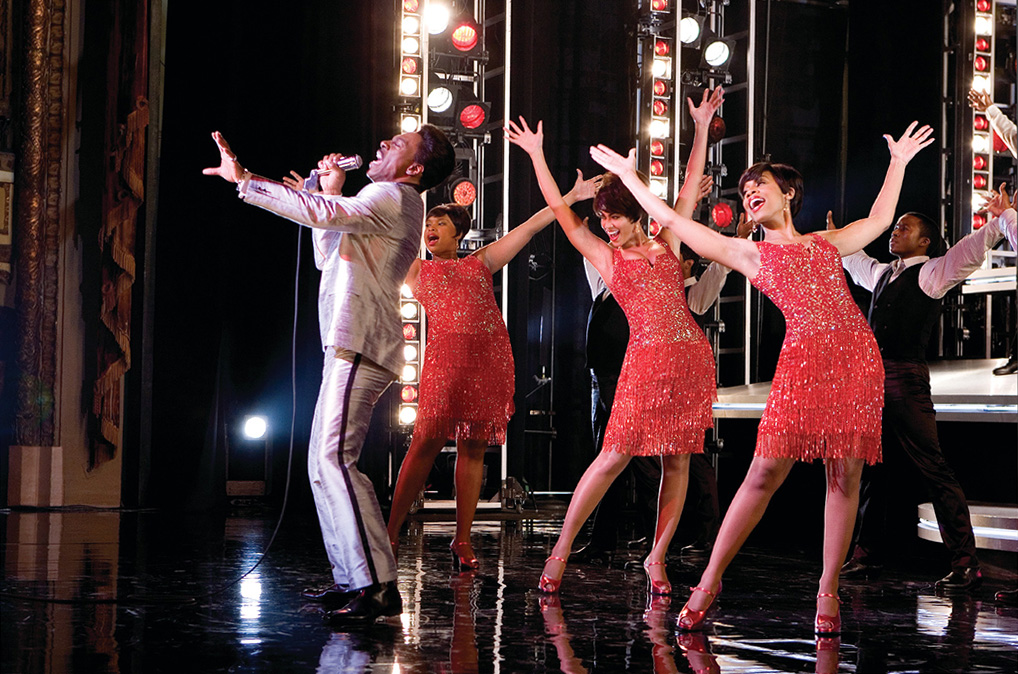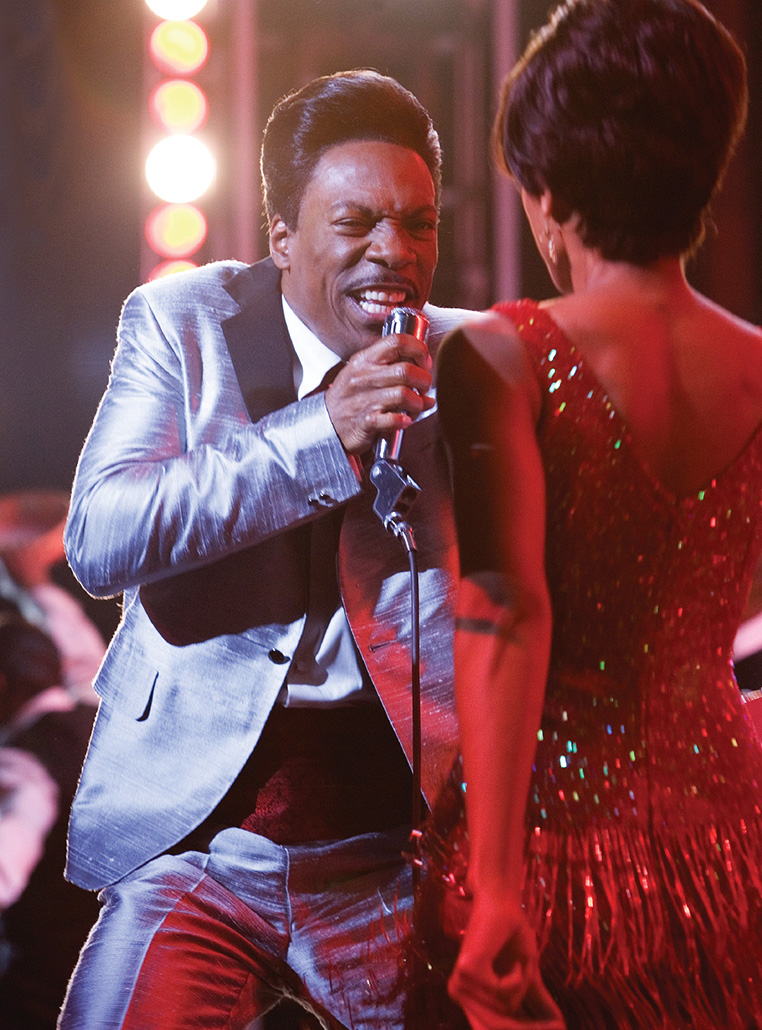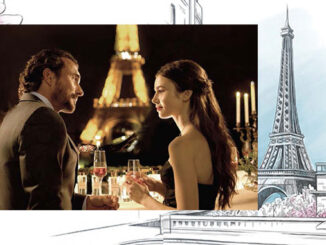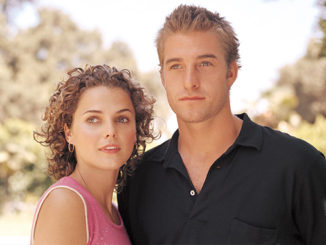
by Rachel Igel
Step into her cutting room, and the only Katz you’ll see answers to the name of Ginny. But supervising this particular Katz are two dogs answering to the names of Tessa and Niki. You won’t see these beautiful Siberian Huskies’ names or paw prints on the credits of any of the many films Virginia Katz, ACE, has edited, but they have been by her side and have provided her with much support over her career. And a considerable career it has been, including features such as the current Dreamgirls, Kinsey (for which she received an Eddie Award nomination from the American Cinema Editors), Jet Li’s Fearless, God and Monsters, Her Majesty and many others, as well as the television shows Alias and Felicity. She also has enjoyed a working partnership with Academy Award-winning writer/ director Bill Condon, which has lasted over 18 years.
Katz grew up in Westchester County, New York, the daughter of film editor Sidney Katz. She moved to Los Angeles in the early 1980s, working on small independent films, larger studio pictures, and television movies and series. Whether exploring human sexuality, martial arts, the Queen of England or the Frankenstein within us, the films Katz has edited have always been provocative and challenging. At this writing, she is currently putting the finishing touches on Dreamgirls, Condon’s film adaptation of the hugely successful theatre musical that opened in LA and New York December 15 and goes wide Christmas Day. Set in the period from the early 1960s to the mid-1970s, the film follows the lives and careers of three women singers who become a pop music sensation after meeting an ambitious manager. Fame takes its toll on them, as their raw, authentic music is co-opted and changed to appeal to a broader audience.
I’ve had the privilege of being Ginny Katz’s close friend for over 25 years––since we first met as assistants on the film All Night Long. She is a pleasure to work with, and her warm and generous spirit characterizes her friendships just as her distinctive talent marks every cut of her films. This interview took place at her home in Studio City, California.

CineMontage: How did you get started in editing?
Virginia Katz: My father, Sid Katz, was an editor in New York and my first mentor. He had his own company and, one summer, he was very busy. I began working with him and basically never left. I think it was two weeks after I had started in the editing room that he gave me a scene to cut. I had no idea what I was doing. I thought that if people were talking, I guess I should be on them. So I literally just cut on the dialogue. When I looked at that first scene, I thought it was a mess. It was so static and staccato and it didn’t work. Little by little, I learned and became more experienced.
In those days, at least in New York, we didn’t hand the film over to a sound or music editor. When I was an assistant, I did a lot of the sound effects and loops myself. It was great fun to be able to do everything. I would sit with the composer, take all the notes and translate them into timings. Once, I was doing sound effects on a foreign film in which there was a bullfight with no sound, because all of the sound elements had been lost. I put in every bull hoof!
CM: You and I both started editing before the digital age. Do you feel your process is any different cutting digitally from working on a Moviola or a KEM?
VK: I was one of the late bloomers going digital. I always loved the feel of film, the texture of film, the look of film––so I was a little hesitant to go onto the Lightworks or the Avid. The last time I edited on film was Candyman: Farewell to the Flesh with Bill Condon. He had never worked on anything but film either, so we cut it on film. For the next project, I learned the Avid, and I thought that if we had worked digitally on Candyman, it would have been so much easier. With film, you’re always waiting for a trim. Once I went on to the Avid––which is now mainly what I work on––I thought it was a miracle.
CM: Do you think there are any disadvantages to working digitally?
VK: No. You don’t get nicks from broken sprockets, you don’t step on film while it’s going through the Moviola and every frame is always there. You’re still taking the scene from a bin––although now it’s a digital bin––and cutting it together. I feel the creative process is the same.
“Once the director is in and we have deadlines we have to meet, we really are working non-stop. There is no personal life. That’s what you give up.” – Virginia Katz
CM: Aside from your father, did you have any other mentors?
VK: There were two mentors in my life: my dad, and when I came to California, an editor named Marion Rothman. She was my other mentor, but in a very different way. I had never worked with a woman before and her approach to editing was very different from my father’s. I learned a different side of the editing world, from a woman’s point of view. At that time, there were not too many women editors. Marion was a very strong woman and a wonderful editor. She and my dad; I feel very lucky to have had two.
CM: You have a very close working relationship with Bill Condon. Can you talk a little bit about how you got started working with him and what kind of relationship you have?
VK: I had been assisting Marion for a couple of years and she was hired to work on a movie called Sister, Sister. The director was Bill Condon. It was his first feature as a director, and I ended up doing some editing on that. Bill and I just seemed to hit it off. We connected on some level. He knew my work, and when he went on to direct a TV movie, he asked me to cut it. I’ve cut everything he’s done since then. That was some 18 years ago and here we are on Dreamgirls.
CM: Condon is a writer as well as a director. Do you feel that affects your working relationship with him in the cutting room––in a different way than it would with someone who is just a director?
VK: I think that when a director is a talented writer as well, and gets to direct what he writes, it makes a big difference. He has visualized it as he wrote it. He absolutely knows what he wants to do in the shooting stage and I think that’s the best combination. Of course, we have also worked on things that he hasn’t written and he still knows what he wants. He has incredible vision.
“It always feels more human when in a drama there is also something that has a comedic side to it” – Virginia Katz
CM: Even though it’s a musical, Dreamgirls is really more like an opera in the sense that the music propels the story and is an integral part in the telling of it. What were the particular challenges of editing this film?
VK: Many. Firstly, I don’t think I’ve ever seen more film in my life! I think we had about a million feet. I guess editing a musical is like editing anything else. But the thing that was different is that you have a limited length. Let’s say a song is three minutes long. You can’t cut outside those three minutes. In other words, you’re locked into getting the story across in the time that the song takes. That was an adjustment. However, we had four cameras going most of the time, so there were many choices. In one number in particular, we had something like 200 clips. My assistant, Ian Slater––who made my job so much easier––had to figure out how to get that amount of footage into the Avid in a way that I could work with it.
We just had a massive amount of film, and you still have the limitations of time. They were shooting constantly. The first two weeks, they did the talent show, which basically takes up the first half-hour of the movie and has five numbers. They have 32 numbers in the movie! It took three days just to look at the dailies from the “Steppin’” number. I could have spent a week on that alone.
CM: What about the choreography?
VK: The choreography is another thing that came into play, because every step of the numbers is choreographed. You want to be able to see what the performers are doing and not make it like MTV. I mean, you want to see them move and you want to see the actual dancing––as opposed to quick cuts of just elbows, knees or feet. This is very much in the old style of musicals in the storytelling––like somebody breaking out into song, which you don’t see that often. I think that’s what you’re talking about when you say it’s very operatic.
CM: The action does not stop for the song.
VK: Right. There’s a scene where the girls are sitting by the mirrors after a number. Curtis [Jamie Foxx] comes in, the girls are about to go on stage on their own and everybody is excited. Effie [Jennifer Hudson] is the one who has always sung lead. Curtis turns to Effie and says that from now on, Deena [Beyoncé Knowles] is going to sing lead. It’s a very pivotal moment. Effie is confronted with the fact that she’s being put in the back––even though she’s got the big voice. She starts to sing about how she feels, and you’ve been led, in a very natural way, into the musical number.
“I’m proud of my work and I love working with Bill [Condon]. Even though sometimes we’re ready to kill ourselves––and maybe each other––we laugh and we have a great time. There’s a balance in there somewhere.” – Virginia Katz
CM: You’ve worked with Condon on a number of other projects, including Kinsey, which was quite a challenge from an editorial point of view. There were a lot of montages in that film, a lot of cutting back and forth in time. How were you able to create such a seamless sense of continuity in that film?
VK: Thank you for that. There were two big montages. The first one is where Kinsey starts to travel around the country doing research. He has a detailed sexual questionnaire. Bill shot 89 interviews–– the faces. I started layering, and with the additional travel footage, the montage took off. We had so many layers that it took hours to render.
CM: You also did a film in Chinese called Jet Li’s Fearless. It must have been difficult to edit a movie in a language that you don’t speak.
VK: I had a lot of sleepless nights before I started that! [Laughs.] The film was shot in China. The story is about a man who discovers himself. My agent had called and mentioned that the director, Ronnie Yu, had seen Kinsey and wanted an American and a female as editor. This is where I met my assistant, Ian. I had no English script at first, but I did get one eventually. There was another editor working on the fight sequences and I was to do everything else.
All of the scenes were in Chinese. I loved the idea of cutting rhythmically, because there was a rhythm to the speech patterns and you could see the emotion on their faces. It was almost like cutting a silent movie. I had hired another assistant, Quan, who was from China. He would translate for me if needed. I was worried that I might cut a line thinking that the end of the pause was the end of a thought pattern or a sentence. When I finished cutting a scene, I’d show it to him just to make sure it made sense.
CM: What is most important to you in the films you enjoy watching?
VK: I think it always comes down to the story and whether the story works for me. It doesn’t matter if it’s comedy or drama or musical. If the story works, then usually the movie works. I love dramas and I love comedies. Not so much slapstick-type comedies, but dramas with humor.

CM: Kind of like All Night Long. A subtle film with a European sensibility.
VK: Yes, very much like All Night Long. I loved that film. To me, it always feels more human when in a drama there is also something that has a comedic side to it––because that’s life. Bill is always really good at that, doing those kinds of stories, like with Gods and Monsters. Serious subject, but some wonderful humorous moments, and it elevates the movie. If it’s constantly plodding and serious, it starts to wear me down.
CM: There were some wonderful performances in Gods and Monsters. How would you compare cutting a really great performance to cutting a really terrible one, where you have to create the performance in the editing?
VK: Well, let’s just say I would take Ian McKellen over anybody. He’s fabulous. He could turn his back after they say, “Cut,” and I would think that was the most beautiful turn I’d ever seen. A great actor can say any line, no matter how ridiculous, and you believe it because they’re so good. They’re in that world where they have created a character that you believe. If I don’t believe a role, the movie falls apart for me. So I think it’s much more challenging to create a performance if you have to.
CM: Do you have much input into the script? Since you know Condon so well, does he bring you in at an earlier stage to give him your thoughts?
VK: Yes. I think I read the Kinsey script just after he finished writing it. I always read them early on. I give him my thoughts and he takes them, or not––that’s up to him. On Kinsey, there was one scene in the script, and I kept saying, “Oh, that’s not going to be in the film; we’ll just leave that on the cutting room floor.” He wasn’t going to take it out of the script. And when it was shot, it was such a powerful scene. I think it was the scene with the pedophile. So vivid, and it’s such a turning point in the movie. I realized that it was a wonderful scene.
“We just had a massive amount of film, and you still have the limitations of time. They were shooting constantly. The first two weeks, they did the talent show, which basically takes up the first half-hour of the movie and has five numbers.” – Virginia Katz
CM: It came alive in the shooting.
VK: Yes, absolutely. Bill is always very open to whatever I have to say. In the editing room, I’ll fight for something for a long time. In Gods and Monsters, there is a scene where James Whale [McKellen] meets Clayton [Brendan Fraser]. Whale says to him, “You have a great profile, a great face,” and Clayton moves his nose. It was a moment that I loved. At some point, Bill said, “Let’s take that out.” I said, “No, you can’t take that out.” And it went back and forth. And when it was out, I must have driven Bill crazy because every time it passed, I would say, “We have to put that back in!” It did go back in for a screening. It got a great reaction and it stayed in.
CM: You worked with J.J. Abrams on a number of TV shows, including Alias and Felicity. How would you compare the experiences of working in TV to working on a feature?
VK: What is more satisfying to me about movies is that you have more time. On Alias, we had six days to shoot, maybe four days to get it into a first cut and then immediately the directors came in. If a show goes over its schedule, all of a sudden you’ll have dailies coming in from the next show and you’re still finishing the show before. There’s no downtime in television.
CM: How do you balance your work life and your personal life?
VK: I have no personal life! Seriously, when we were shooting Dreamgirls, I had so much film that I was kind of working around the clock. I could still take off and go have dinner with a friend. But once the director is in and we have deadlines we have to meet, we really are working non-stop. There is no personal life. That’s what you give up. I get home at 8:30, 9:30, and I’m not going to go out at 9:30. I’m going to go to sleep. You do have to put your life on hold, and hopefully the people around you understand that. My friends do, and my family does. You really do give up your life for a while. That’s the hard part.

CM: What do you think is the best part?
VK: The best part for me is that I love what I do. I love editing and the creative process. And I’m proud of my work and I love working with Bill. Even though sometimes we’re ready to kill ourselves––and maybe each other––we laugh and we have a great time. There’s a balance in there somewhere. Also, when you work really hard for what will be, for me, nearly a year on this, you then get to take time off. If I want to stay in bed for two weeks, I can do that. You make up for it on the other side.
CM: Are there any working experiences that stand out in your career as particularly wonderful or terrible?
VK: Dreamgirls is the most challenging film I’ve ever worked on. I love the music and everything about it. I can’t remember having any really bad experiences. I’ve heard friends’ stories, but I’ve always felt kind of sheltered from that because of having started off with my father and then with Marion. Both of them, as you know, turned off their Moviolas at 7:00 p.m.
I’ve also gone on some great locations. I enjoyed Her Majesty, the film I did in New Zealand. I feel like I’ve been very lucky. As an assistant, I remember there was a film where the editor actually threw a reel at the director––an actual reel of film. They’d have these big fights and then make up.
CM: Sometimes, while cutting a scene, there is a time when it’s all coming together and one experiences a moment of incredible elation––the feeling that you’ve taken the scene to another level. Do you remember any highs like that?
VK: I remember one evening on Gods and Monsters, Bill and I were working late. It was a very emotional scene where Whale is sitting in the kitchen with Clayton and he’s trying to get Clayton to kill him. We found this one look from Ian McKellen, where he looks at Brendan Fraser and it really did take the scene to a higher level. It told the whole story. Bill and I looked at each other and we both felt that unbelievable moment that does not happen very often––when you hit on something that just takes the scene to a place where you wish it would be. Rarely have I felt that moment of total awareness of the meaning of a scene. Those are amazing moments.





